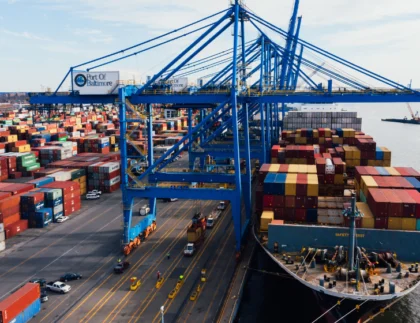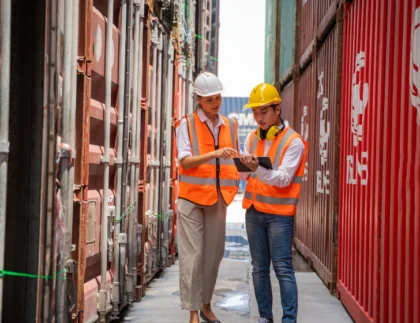
The global freight forwarding industry faces unprecedented challenges due to climate change logistics. Rising global temperatures, extreme weather events, shifting regulations, and increasing environmental consciousness among consumers are pushing businesses to rethink their supply chain strategies. Freight transport, which plays a critical role in global trade, is now under pressure to address environmental risk while ensuring efficiency and resilience.
The impact of climate change on logistics is no longer a distant concern. Floods, hurricanes, wildfires, and extreme weather events disrupt supply chains, increasing costs, delays, and damages. To navigate this changing landscape, companies must embrace sustainable freight solutions, adopt green logistics practices, and ensure climate resilience.
This article explores how freight forwarders can mitigate environmental risks in supply chains through supply chain adaptation, environmental freight practices, and risk reduction logistics while ensuring sustainable logistics in their business models.
The Freight Impact of Climate Change on Supply Chains
The transportation and logistics industry contributes significantly to global carbon emissions and climate change logistics issues. According to studies, freight transport accounts for nearly 8% of global carbon emissions, with road, air, and maritime shipping playing significant roles.
Extreme weather conditions caused by climate change are disrupting freight networks globally. Increased frequency and severity of natural disasters like hurricanes and typhoons lead to port closures, damage to infrastructure, and delayed deliveries. Rising sea levels threaten coastal logistics hubs, making climate resilience a pressing concern for companies relying on seaports.
Additionally, regulatory bodies worldwide are imposing stricter emissions policies to curb the environmental damage caused by logistics. Governments and international organizations are pushing supply chain adaptation measures such as carbon taxation, emission reduction mandates, and investments in cleaner transportation technology.
To mitigate these challenges, freight forwarders must focus on environmental freight practices that reduce carbon footprints, improve fuel efficiency, and optimize supply chain operations.
Sustainable Freight: The Future of Logistics
The shift towards sustainable freight is no longer an option—it’s a necessity. Businesses that fail to adapt risk regulatory fines, reputational damage, and operational inefficiencies.

The Role of Green Logistics
Green logistics refers to adopting eco-friendly supply chain practices that minimize environmental damage. These practices include reducing fuel consumption, switching to renewable energy sources, optimizing freight routes, and reducing waste. Many companies invest in electric or hybrid trucks, biofuel-powered ships, and energy-efficient warehouses to lower emissions.
Freight forwarders can also improve sustainability by consolidating shipments and optimizing routes to minimize unnecessary trips. AI-powered logistics solutions can help companies track and reduce fuel consumption, cut emissions, and improve efficiency.
For example, data-driven risk reduction logistics strategies allow freight forwarders to analyze weather patterns and avoid disruptions caused by climate-related events. By leveraging AI and predictive analytics, companies can plan alternative shipping routes in real-time, reducing delays and minimizing the freight impact of environmental disruptions.
Supply Chain Adaptation: Building Climate Resilience
Supply chain adaptation is crucial in mitigating environmental risks caused by climate change. This involves restructuring logistics operations to withstand climate-related disruptions while maintaining efficiency.

Infrastructure Resilience
Freight hubs, warehouses, and transportation networks must be resilient against threats. BusiTo ensure continuity in operations, businesses invest in flood-resistant warehouses, heat-proofed transport vehicles, and hurricane-resistant shipping infrastructure to verify Supply Chains.
Diversification of Supply Chains
Many companies are diversifying their supplier base and distribution centres to reduce vulnerability. Instead of relying on a single supplier or port, businesses are spreading their operations across different regions to minimize climate-related disruptions.
By integrating sustainable logistics solutions, companies can ensure that their supply chains remain operational even during extreme weather events.
Eco-Friendly Packaging and Warehousing
Adopting environmental freight practices also involves sustainable packaging and warehousing techniques. Reducing plastic packaging, using biodegradable materials, and investing in energy-efficient warehouses are critical steps toward sustainability. For instance, warehouses powered by solar energy can significantly lower carbon emissions while cutting operational costs.
Risk Reduction Logistics: Strategies for Sustainable Supply Chains
Investment in Low-Emission Transportation
Transitioning to low-emission vehicles, ships, and aircraft is one of the most effective ways to lower the freight impact of logistics operations. Electric trucks, hydrogen-powered ships, and biofuel-based aircraft are emerging as viable alternatives to traditional transportation methods.
Enhanced Freight Route Optimization
Advancements in logistics technology allow businesses to optimize freight routes and reduce unnecessary fuel consumption. AI-powered freight management systems analyze real-time data to find the most efficient delivery routes, reducing travel distance and emissions.
Collaboration with Eco-Conscious Partners
Businesses must collaborate with logistics partners that prioritize sustainable logistics. Choosing carriers and shipping companies that follow green logistics principles can significantly reduce carbon footprints across supply chains.
Regulatory Compliance and Carbon Offsetting
Freight forwarders must stay ahead of evolving environmental regulations and compliance requirements. Many companies are now investing in carbon offset programs to compensate for emissions by funding reforestation projects or renewable energy initiatives.
For instance, some shipping companies offer carbon-neutral freight services where emissions are offset by investing in sustainable projects.

The Road Ahead: Sustainable Logistics in a Changing World
The need for supply chain adaptation and climate resilience in logistics is more pressing than ever. As climate change continues to impact global trade, freight forwarders must proactively integrate environmental freight practices to ensure sustainability and efficiency.
Businesses that embrace sustainable freight and invest in risk-reduction logistics will minimize environmental damage and gain a competitive edge in the industry. Consumers, investors, and governments increasingly prioritize eco-friendly business practices, making sustainability a key factor in long-term success.
The logistics industry must act now to address environmental risk, improve climate change logistics strategies, and transition to a more sustainable future. Companies that fail to adapt face regulatory challenges, financial losses, and reputational risks.
By incorporating these best practices, the freight forwarding industry can play a crucial role in reducing the freight impact of climate change and ensuring a resilient, eco-friendly future for global supply chains.











